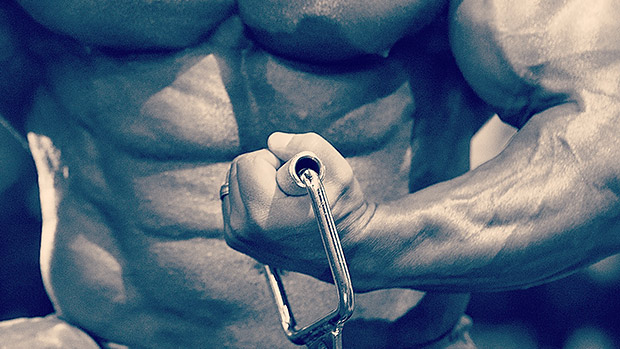Can stretching help you build muscle faster? Yes, if you use a certain type of stretching. What type? Weighted stretching.
You've probably read about how loaded stretching increases activation of the anabolic mTor pathway, increases your active range of motion, and creates an occlusion effect that promotes increased blood flow and delivery of nutrients to muscle cells. So let's take a look at one more benefit.
Most of the benefits of weighted stretching focus on the target muscle. For example, performing a bottom-range dumbbell press hold at the end of a chest workout. But what if we were to stretch the pecs right before doing a set of, say, rear-delt rows?
What you get is increased active range of motion of your row, along with higher output and better quality muscle contractions. How does this work? It's based on the agonist-antagonist relationship: For a muscle to shorten to the desired range, its antagonist must be able to lengthen to accommodate.
Taking the example of the row, the pec minor has to lengthen to allow the rear delts to shorten. The rear delts are the agonist; the pecs are the antagonist.
When the agonist shortens and contracts, the antagonist lengthens and relaxes. This is a slight oversimplification, given that the antagonist doesn't always relax, at least not fully, but you get the idea.
The exercise combos below have been thoroughly tested and work very well:
Clavicular Pec Weighted Stretch – Rear Delt Row
- Cue: Actively pull or "row" into the stretched position.
- Tip: If you're not confident with a heavier loaded hold, do a wide flye stretch with a submaximal load.
Sternocostal Pec Stretch – Lat Focused Pulldown
- Cue: Cue the elbows towards the base of the spine to keep them tight during the stretch.
- Tip: If you can knock out dips comfortably, you could also hold an isometric stretch at the bottom of a dip.
Mid-Trap and Rhomboid Stretch – Pec Dec Flye
- Cue: Think about getting your shoulder blades to your pecs.
- Tip: Use a long rope in a seated cable machine or sit on the floor. Keeping the lumbar as neutral as possible, allow the T-spine to flex while simultaneously protracting as much as you can.
Couch Stretch – Hamstring Curl
- Cue: Actively drive the stretching knee through the floor.
- Tip: If you want to intensify the stretch, reach the arm on the same side overhead and side-bend away from the stretching leg. Want to take it up a notch again? Do it under a squat rack and use a band to further increase the lengthening of the hip flexors.
Weighted Biceps Stretch – Triceps Extension
- Cue: Think of pushing your elbow through your elbow "pit," fully flexing the triceps.
- Tip: Set up the bench at an angle where you can get your elbows behind your torso without the shoulders rounding forward. A 40-50% incline is usually best.
Anterior Tibialis Stretch – Calf Raise
- Cue: Simultaneously push your toes away from you while pulling your heels towards you. Think about creating a straight line with the top of your feet and shin bones.
- Tip: If you have bum knees, then an option is to use a rear-foot elevated split squat with active plantar flexion.
These stretches are performed in one of two ways:
- A constant isometric contraction in the lengthened position of the antagonist with a moderate load.
- Multiple smaller holds of 3-5 seconds with submaximal loads.
Use either method and allow 20-30 seconds between the weighted stretch and performing your working set.
You should be able to shorten the target muscle to a significantly greater degree than normal, thus increasing your ability to maximally contract the muscle. Increased stimulus equals increased gains!





